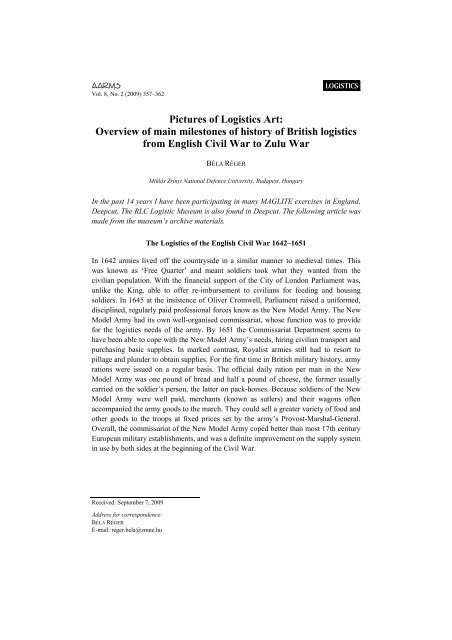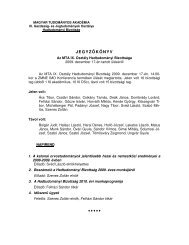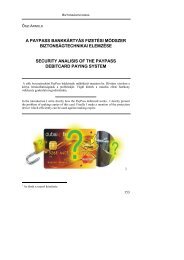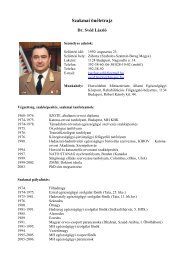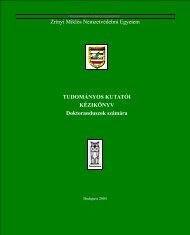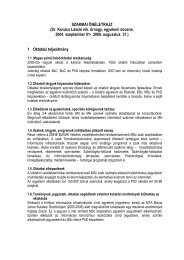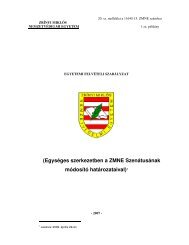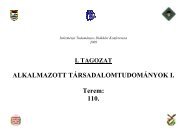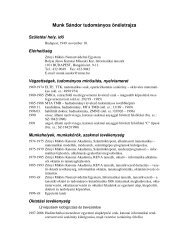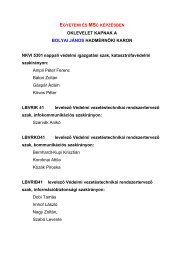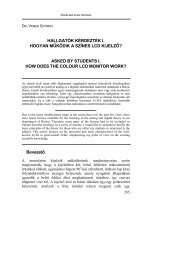Pictures of Logistics Art: Overview of main milestones of history of ...
Pictures of Logistics Art: Overview of main milestones of history of ...
Pictures of Logistics Art: Overview of main milestones of history of ...
You also want an ePaper? Increase the reach of your titles
YUMPU automatically turns print PDFs into web optimized ePapers that Google loves.
AARMS LOGISTICS<br />
Vol. 8, No. 2 (2009) 357–362<br />
<strong>Pictures</strong> <strong>of</strong> <strong>Logistics</strong> <strong>Art</strong>:<br />
<strong>Overview</strong> <strong>of</strong> <strong>main</strong> <strong>milestones</strong> <strong>of</strong> <strong>history</strong> <strong>of</strong> British logistics<br />
from English Civil War to Zulu War<br />
Received: September 7, 2009<br />
Address for correspondence:<br />
BÉLA RÉGER<br />
E-mail: reger.bela@zmne.hu<br />
BÉLA RÉGER<br />
Miklós Zrínyi National Defence University, Budapest, Hungary<br />
In the past 14 years I have been participating in many MAGLITE exercises in England,<br />
Deepcut. The RLC Logistic Museum is also found in Deepcut. The following article was<br />
made from the museum’s archive materials.<br />
The <strong>Logistics</strong> <strong>of</strong> the English Civil War 1642–1651<br />
In 1642 armies lived <strong>of</strong>f the countryside in a similar manner to medieval times. This<br />
was known as ‘Free Quarter’ and meant soldiers took what they wanted from the<br />
civilian population. With the financial support <strong>of</strong> the City <strong>of</strong> London Parliament was,<br />
unlike the King, able to <strong>of</strong>fer re-imbursement to civilians for feeding and housing<br />
soldiers. In 1645 at the insistence <strong>of</strong> Oliver Cromwell, Parliament raised a uniformed,<br />
disciplined, regularly paid pr<strong>of</strong>essional forces know as the New Model Army. The New<br />
Model Army had its own well-organised commissariat, whose function was to provide<br />
for the logistics needs <strong>of</strong> the army. By 1651 the Commissariat Department seems to<br />
have been able to cope with the New Model Army’s needs, hiring civilian transport and<br />
purchasing basic supplies. In marked contrast, Royalist armies still had to resort to<br />
pillage and plunder to obtain supplies. For the first time in British military <strong>history</strong>, army<br />
rations were issued on a regular basis. The <strong>of</strong>ficial daily ration per man in the New<br />
Model Army was one pound <strong>of</strong> bread and half a pound <strong>of</strong> cheese, the former usually<br />
carried on the soldier’s person, the latter on pack-horses. Because soldiers <strong>of</strong> the New<br />
Model Army were well paid, merchants (known as sutlers) and their wagons <strong>of</strong>ten<br />
accompanied the army goods to the march. They could sell a greater variety <strong>of</strong> food and<br />
other goods to the troops at fixed prices set by the army’s Provost-Marshal-General.<br />
Overall, the commissariat <strong>of</strong> the New Model Army coped better than most 17 th century<br />
European military establishments, and was a definite improvement on the supply system<br />
in use by both sides at the beginning <strong>of</strong> the Civil War.
B. RÉGER: <strong>Pictures</strong> <strong>of</strong> <strong>Logistics</strong> <strong>Art</strong><br />
Supplying Marlborough’s Army 1701–1714<br />
Supply and transport arrangements for the Duke <strong>of</strong> Marlborough’s army depended<br />
entirely on civilian contractors, working to the orders <strong>of</strong> Marlborough’s staff through<br />
agents <strong>of</strong> the Commissariat Department, known as commissaries. The Commissariat<br />
Department was answerable to the Treasury, and the efficiency <strong>of</strong> the commissaries<br />
depended on the ready availability <strong>of</strong> cash, as well as the sometimes questionable<br />
honesty <strong>of</strong> the contractors and the resources <strong>of</strong> the theatre <strong>of</strong> operations. In the<br />
relatively prosperous Law Countries, the Rhine Valley and southern Germany, under<br />
Marlborough’s scrutiny, the system worked well and, unlike some armies <strong>of</strong> the period<br />
which almost starved at times, Marlborough’s soldiers seldom lacked their daily bread.<br />
The core <strong>of</strong> Marlborough’s system <strong>of</strong> transport and supply in Flanders was a huge<br />
contract with Solomon and Moses Medina for providing the army with bread and<br />
wagons. The monies paid by the Medina brothers for being awarded the contract helped<br />
fund the Secret as there Intelligence Service. One ‘bread wagon’ was allowed to each<br />
regiment. Bread wagons were the only public service <strong>of</strong> transport for the army, and<br />
were used for a variety <strong>of</strong> purposes, including carrying ammunition or moving guns. A<br />
two-wheeled cart, or tumbrel, is thought to have been invented by Marlborough himself.<br />
On the march all vehicles and baggage animals were subject to the Wagon-Master-<br />
General. The penalty for moving without his orders or straying from their place without<br />
his permission was that the load should be plundered immediately. For supplies other<br />
than bread and ammunition the British soldier depended on sutlers. Each regiment had<br />
its own civilian sutlers, both male and female. These provided luxuries like meat and<br />
liquor, acquired through lawful trading or simple plundering. The most famous sutler <strong>of</strong><br />
Marlborough’s army was Christine Davies, also known as Mother Ross. She preferred<br />
being with the ‘Forlorn Hope’ or Advance Guard, would be fewer rivals to share any<br />
plunder with. Daniel Defoe wrote about her in his book ‘The Life and Adventures <strong>of</strong><br />
Mrs Christine Davies.’<br />
Military Transport in the Napoleonic Wars 1789–1815<br />
The old military transport system in use at the outbreak <strong>of</strong> war with Revolutionary<br />
France relied <strong>main</strong>ly on civilians, and functioned slowly and <strong>of</strong>ten inefficiently. Each<br />
move during a campaign involved re-negotiating rates, organising new drivers and<br />
coping with animals <strong>of</strong> varying quality. It was not until the Duke <strong>of</strong> York raised an<br />
army in 1794 to fight the French in the Low Countries that the need for an alternative<br />
system to operate military transport was finally recognised. The Corps <strong>of</strong> Wagoners was<br />
358 AARMS 8(2) (2009)
B. RÉGER: <strong>Pictures</strong> <strong>of</strong> <strong>Logistics</strong> <strong>Art</strong><br />
authorised by Royal Warrant on 7 th March 1794. The Corps consisted <strong>of</strong> 500 men and<br />
its <strong>main</strong> function was to supplement the huge variety <strong>of</strong> hired civilian wagons and pack<br />
animals operated by the Commissariat. With poor quality soldiers and no effective<br />
leadership the transport organisation in Flanders fared as badly as the rest <strong>of</strong> the army in<br />
an ultimately unsuccessful camping. On their return to England in 1796 the Corps <strong>of</strong><br />
Wagoners were disbanded. Another transport organisation, the Royal Wagon Corps,<br />
was established in 1799 for an expedition to the Netherlands. In 1802 the Royal Wagon<br />
Crops became the Royal Wagon Train. By 1808 the Royal Wagon Train was nearly<br />
2000 strong, divided into 12 troops. The Royal Wagon Train, although small compared<br />
with the 400 bullock carts and 12000 pack animals hired by the Commissariat for their<br />
own and Ordnance Board stores and equipment, gave vital support to the British Army<br />
under Wellington during the Peninsular War in Spain. Conditions tested the Train to the<br />
full, with huge distances to cover and sometimes appalling weather conditions, as well<br />
as unreliable sources and uncooperative Spaniards. As a result the Royal Wagon Train’s<br />
achievements, it was awarded the battle honour ‘Peninsula’ on 6th April 1815.<br />
The Royal Wagon Train at the Battle <strong>of</strong> Waterloo 1815<br />
Wellington’s campaigns in Spain and Southern France culminated in the defeat <strong>of</strong><br />
Napoleon in 1814. Napoleon escaped from prison in the following year and confronted<br />
the British and their allies at the Battle <strong>of</strong> Waterloo in Belgium. The Royal Wagon<br />
Train was 8 troops strong at this time, and consisted <strong>of</strong> 1072 <strong>of</strong>ficers and men, 1440<br />
horses, 100 spring wagons, 5 store, 5 forage and 27 forge wagon. Four Hanoverian<br />
(German) troops were raised to bring the Train up to 12 troops, but were not present at<br />
Waterloo. As in the Peninsular War, the Royal Wagon Train was deployed in<br />
attachments to cavalry and infantry regiments and used as an ambulance service. One<br />
forge wagon was attached to each cavalry regiment and one spring wagon to each<br />
infantry regiment. The spring wagons were used to carry the sick and wounded.<br />
Although at Waterloo it was <strong>main</strong>ly the wagons hired by the Commissariat that were<br />
used for the transport <strong>of</strong> supplies, Private Brewer <strong>of</strong> the Royal Wagon Train<br />
distinguished himself by bringing vital supplies <strong>of</strong> ammunition to the Light Companies<br />
<strong>of</strong> the Foot Guards defending Hougoumont Chateau. Wellington’s victory over<br />
Napoleon at Waterloo was a turning point in <strong>history</strong>. There would be no war on such a<br />
scale in Europe for a century. The battle also marked the end <strong>of</strong> a long series <strong>of</strong> wars<br />
with France and major British involvement on the continent <strong>of</strong> Europe. As a mark <strong>of</strong><br />
esteem, all British <strong>of</strong>ficers present at Waterloo had the letter ‘W’ placed against their<br />
names in the Army List, all men were styled ‘Waterloo men’ and were granted special<br />
AARMS 8(2) (2009) 359
B. RÉGER: <strong>Pictures</strong> <strong>of</strong> <strong>Logistics</strong> <strong>Art</strong><br />
pension. In 1816 the Royal Wagon Train was awarded the battle honour ‘Waterloo’.<br />
Wellington wrote in 1816: “No person can be more impressed then I am <strong>of</strong> the necessity<br />
<strong>of</strong> a corps <strong>of</strong> the description <strong>of</strong> the Royal Wagon Train...” In spite <strong>of</strong> his protests, the<br />
Royal Wagon Train was disbanded in 1833 as a result <strong>of</strong> defence cuts.<br />
Logistic Developments in the Victorian Era<br />
During the twelve years from 1855 to 1867 which followed the administrative disaster<br />
<strong>of</strong> the Crimean War, no less than seventeen Royal Commission and nineteen War<br />
Office Committees examined the supply and transport needs <strong>of</strong> the army. In 1856 a<br />
Royal Warrant authorised the formation <strong>of</strong> a permanent military transport corps, the<br />
Military Train. It ultimately consisted <strong>of</strong> seven battalions, and drew its personnel from<br />
the best <strong>of</strong>ficers and men <strong>of</strong> the old Land Transport Corps and various cavalry<br />
regiments. The Military Train served in India during the Mutiny, in China, New<br />
Zealand where it was commended for a cavalry charge and Abyssinia. As local<br />
transport arrangements had already been made in many <strong>of</strong> the campaigns fought at this<br />
time, the Military Train operated <strong>main</strong>ly as light cavalry. On 4 th November 1861 the<br />
Military was awarded the Battle Honours ‘Pekin’ and ‘Taku Forts’ for its services in<br />
China in 1860. On3rd September 1863 the Military Train was awarded the Battle<br />
Honour ‘Lucknow’ for its services in India during the Mutiny from 1857 to 1858. Two<br />
VCs were also won by the members <strong>of</strong> the Train during the campaign. In 1859 a<br />
Commissariat Staff Crops was raised, consisting entirely <strong>of</strong> soldiers who served under<br />
non-combatant Commissariat <strong>of</strong>ficers. Unlike its predecessor, the Commissariat<br />
Department, the Commissariat Staff Crops was a military units existed. In 1869 the<br />
Commissariat Staff Crops and Military Train were absorbed into a Control Department.<br />
This was an Officer Corps who commanded a small soldiers-only Army Service Corps.<br />
The following decades saw a number <strong>of</strong> re-organisations <strong>of</strong> the army’s supply and<br />
transport organisations. In 1888, General Sir Redvers Buller, then Quarter Master<br />
General, insisted that the supply and transport units should be staffed by <strong>of</strong>ficers<br />
wearing the same uniform and badges as their men. The result was the formation in<br />
1889 <strong>of</strong> a second, integrated Army Service Corps. After its abolition in 1855, the<br />
civilian storekeepers <strong>of</strong> the Board <strong>of</strong> Ordnance were formed into a Military Store<br />
Department, whose <strong>of</strong>ficers held army commissions. By 1896 ordnance Department in<br />
command <strong>of</strong> a soldiers-only Army Ordnance Corps.<br />
360 AARMS 8(2) (2009)
Supply and Transport in the Zulu War 1879<br />
B. RÉGER: <strong>Pictures</strong> <strong>of</strong> <strong>Logistics</strong> <strong>Art</strong><br />
A British infantry battalion <strong>of</strong> 500–800 men had to carry its own ammunition, tents,<br />
entrenching tools, medical equipment and rations. In Zululand the latter consisted <strong>of</strong><br />
‘mealies’ (local corn carried in 200lb. bags), army biscuit and tinned ‘bully beef’. Fresh<br />
meat and vegetables were procured when available. These requirements alone could<br />
take up 17 wagons. without the luxury <strong>of</strong> the <strong>of</strong>ficer’s personnel baggage, and the men’s<br />
bottled beer. If there was no fuel around, that too had to be transported. For cavalry<br />
regiments, whose British-bred horses would not eat coarse local grasses, fodder had to<br />
be carried. There were limited number <strong>of</strong> army General Service wagons available, but<br />
their narrow carriage, intended for European roads, made them unstable in southern<br />
Africa. Lord Chelmsford’s harassed and inexperienced transport staff had to purchase<br />
local transport, <strong>of</strong>ten at inflated prices. The wagons were large and heavy, requiring<br />
between 16 and 18 oxen apiece to pull them. For the oxen to re<strong>main</strong> healthy they<br />
needed 16 hours each day for rest and grazing, which reduced their travelling potential<br />
to about ten miles per day. In bad conditions it was much less. Transport shortage<br />
re<strong>main</strong>ed a major problem throughout the war, and dominated British strategy. The<br />
camp at Isandlwana was unlagered because the wagons were about to return to Rorke’s<br />
Drift to fetch supplies, Rorke’s Drift proved so defensible because the supplies were<br />
available to build barricades. Lord Chelmsford’s extremely slow advance to relieve<br />
Colonel Pearson’s Column at Eshowe, in the process <strong>of</strong> which he was able to defeat the<br />
Zulus at Ginginhlovo, led him to remark ‘Ox wagon transport is enough to destroy the<br />
reputation <strong>of</strong> any number <strong>of</strong> commanders’. Colonel Evelyn Wood earned a considerable<br />
reputation for logistic skill during the Zulu War. He ensured that his men received fresh<br />
bread and meat every day while the rest <strong>of</strong> the army fed on ship’s biscuits. Together<br />
whit his assistant Redvers Buller, he evolved a system whereby Army Service Corps<br />
bakers with their ovens in wagons under escort were sent ahead <strong>of</strong> the Column to the<br />
next campsite. There they produced fresh bread to await the arrival <strong>of</strong> incoming men.<br />
The Commissariat at Rorke’s Drift<br />
After their overwhelming victory over the British at Isandlwana on January 22, 1879,<br />
the Zulus under Cetshwayo pressed into Northern Netal that night. At the supply depot<br />
at Rorke’s Drift 140 British troops resisted the advance <strong>of</strong> 4000 Zulu warriors. After an<br />
all-night assault, on January 22–23, the Zulus withdrew, leaving 400 dead on the field.<br />
The heroic garrison, under the command <strong>of</strong> Lieutenants Chard and Bromhead, suffered<br />
25 casualties. II Victoria Crosses were awarded for the battle. Commissariat and<br />
AARMS 8(2) (2009) 361
B. RÉGER: <strong>Pictures</strong> <strong>of</strong> <strong>Logistics</strong> <strong>Art</strong><br />
Transport Department <strong>of</strong>ficers, technically non-combatants, played a vital part in the<br />
defence <strong>of</strong> Rorke’s Drift. Acting Assistant Commissary James Dalton actively<br />
superintended the work <strong>of</strong> defence. Dalton was amongst the foremost <strong>of</strong> those who<br />
received the first attack at the corner <strong>of</strong> the hospital, where the deadliness <strong>of</strong> his fire<br />
checked the ferocious rush <strong>of</strong> the enemy. He also saved the life <strong>of</strong> a man in the Army<br />
Hospital Corps by shooting the Zulu who was attacking him. Assistant Commissary<br />
Walter Dunne supervised the erection <strong>of</strong> the defences including the mealie bag redoubt<br />
meant as the last rallying point. Dunne encouraged the exhausted soldiers while<br />
standing on the growing pile <strong>of</strong> bags high above the defences, drawing fire on himself<br />
and ignoring any danger. Acting Storekeeper Louis Byrne was instrumental in forming<br />
the entrenchment <strong>of</strong> biscuit boxes that made a vital contribution to the successful<br />
defence <strong>of</strong> the outpost. He was shot in the head by a Zulu while in the act <strong>of</strong> giving a<br />
drink to a wounded man. Throughout the action Sergeant Francis Attwood <strong>of</strong> the Army<br />
Service Corps successfully held at by Zulu warriors trying to set fire to the thatched<br />
ro<strong>of</strong> <strong>of</strong> the store-house. Dalton was later awarded the Victoria Cross for his part in the<br />
action, while Dunne was unsuccessfully recommended for the Victoria Cross by Lord<br />
Chelmsford himself. Attwood received the Distinguished Conduct Medal and Byrne<br />
was posthumously mentioned in despatched.<br />
362 AARMS 8(2) (2009)


